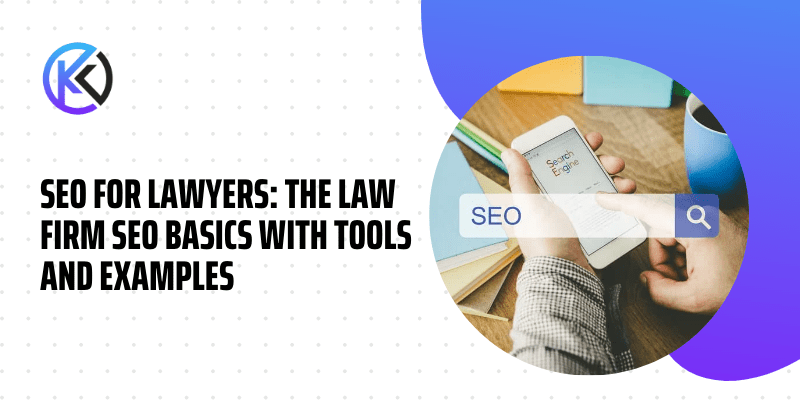What is SEO?
Search Engine Optimization (short for “SEO”) is improving the volume and quality of traffic to a given website via organic means. In general, the earlier (better ranked) and more frequently a site appears in the SERPs, the greater chance it has of driving traffic and generating revenue.
The most important aspect of SEO is ensuring that your content is relevant to what people are searching for. This is achieved by creating unique, high-quality content regularly. It’s also essential to make sure that you have good internal linking within your pages. You can’t expect users to click through from one page to another without a clear link or path between them.
When doing SEO for law firms, it pays off!
Organic SEO is essential in growing your law practice and getting organic traffic. According to the 2019 Law Practice Marketing Trends Survey, 17 percent of lawyers look for a lawyer through online Google searches.
A comprehensive SEO strategy is essential to attract clients and continue creating content that engages and converts your audiences. Seventy-five percent of internet users never scroll past the first page of search results; appearing on page one in organic searches can provide law firms with many benefits, such as ranking on the first page in the organic rankings and on Google Maps.
There are approximately 1.3 million lawyers in the United States, so it’s a highly competitive market.
It may be hard to understand initially, but SEO is an integral part of any basic marketing plan for law offices.
Law firms should always use SEO because they help to get their names out there and increase search engine rankings.
Before we get started, let’s outline the basics of Lawyer SEO and why it matters for lawyers and legal practices.
What are Google’s ranking factors?
There are four main things that your website must focus on if it wants to succeed at achieving good SEO results. They are:
- Content
- Link-building
- Technical SEO
- User Experience (UX).
Let’s take a closer look at each one of them. We will then continue discussing Google ranking factors to help boost your Google Maps rankings for your law firm.
Law Firm SEO ranking factor: Content is King
Content refers to your website’s web page, blogs, articles, images, and videos. It’s how you interact with visitors and is critical to determining whether they stay on the site or leave. We’ll discuss how to create compelling content that will encourage people to visit your site and return again and again.
Good SEO content includes keywords, links, images, videos, etc.
Good SEO content is a combination of several factors. It’s not just about the quality and quantity of your writing but also about how you write it.
In this post, I will share some tips on creating great SEO content that ranks well in search engines.
1.) Write for humans first and then for search engines.
The most important thing to remember when writing any article is to keep your audience in mind. You must write for them, not yourself. Your readers come to your site searching for answers to questions related to your niche. Don’t make them leave your site without having answered those questions. Ensure you provide helpful information and resources so your visitors can find what they’re searching for.
Make sure you don’t duplicate content from one page to another. Use canonical tags to specify which version of the page is the original. I suggest checking for duplicate content issues on Copyscape.com.
Create unique, relevant content that solves problems and provides value to your audience.
2.) Use keywords naturally
When you’re writing, try to incorporate keywords as much as possible. Keywords are the foundation of any SEO strategy. Keywords are the words people use to search for something on the internet. They are usually short phrases like “best personal injury lawyer” or “best personal injury lawyers near me.” When someone types these keywords into a search engine, they want results containing those exact terms. Legal keywords are very competitive, and I’d suggest researching less competitive keywords for quick wins.
The Ahrefs Keyword Explorer tool is a good starting place for checking the keyword difficulties of different terms and finding ones within your grasp if you’re starting fresh; target terms with a keyword score between 0-10.
Another keyword reach tool I’d recommend is Keywordtool.io. This tool will help you find the most profitable keywords for your website or blog. It’s free to use, and it does not require any registration. You can generate as many keyword lists as you want, but we recommend using only one list simultaneously. This way, you’ll be able to compare them side by side and see which ones are more effective.
Longtail keywords are often overlooked, but they can help increase rankings. An excellent way to find longtail keywords is through competitor research. If you do this right, you’ll be able to optimize your content for both humans and search engines.
3.) Make it easy to find using Silo structures for law firm websites
If your content isn’t easily accessible, no one will ever see it. The best way to ensure your content is found is to make it visible on your homepage.
You can use silos to create multiple pages within a single site focusing on different keywords or phrases. SEO for lawyers calls this the “Silo” strategy, a term coined by Bruce Clay.
Content silos help Google determine which types of content should rank for particular keywords. If you’re looking to get ranked for a specific keyword phrase, silos are great because they allow you to create supporting pages that contain additional info about your main page. These pages help build credibility and increase traffic.
Each supporting page should have its unique URL. Your supporting pages should connect to your main landing page through a link.
Don’t forget to add a call to action button to encourage visitors to contact you.
4.) Obtain backlinks from high domain authority legal sites.
Links are one of the most powerful ways to increase the visibility of your content. They allow readers to navigate directly to other parts of your site. Content needs to support itself through internal linking and usability. Internal linking helps readers navigate your site.
Domain Authority (DA) indicates your site’s well-optimized for search engines. Domain authority suggests how well a site ranks in search engines. DA is calculated based on the number of backlinks pointing toward your website. A higher DA will give you a higher position in the rankings. Your domain authority is calculated based on many factors, including link popularity, the number of unique domains linking to your site, and the overall trustworthiness of those linking domains.
Domain authority is an excellent way to compare your website against your competition. Domain Authority is a metric for measuring how important a particular site is compared to others. A website with a DA of 100 will rank better than one with a DA of 50. Popular websites often have a DA of 100 or above.
Backlinks help build your authority online. A good rule of thumb is to focus on building backlinks from authoritative sites. Don’t just throw backlinks onto any site. Make sure they’re relevant.
Other factors that may help improve your law firm’s website’s domain authorities include:
- Your site structure should be clean and organized.
- Make sure all of your pages link to each other.
- An excellent way to organize your pages is to create a hierarchy of pages.
5.) Be consistent
Social media is another great way to promote your business. It allows you to reach out to potential clients and customers. Social media also allows you to share content with your target audience.
Consistency is key. Create relevant content that is similar to all of your other content. For example, don’t publish different types of posts every day. Instead, stick to publishing one type of content per week.
6.) Optimize your images
Images play a huge role in SEO. Images can add context to your text, making it easier to understand.
Images are great for increasing the amount of information you can convey in a single article. They also make your content look more professional.
7.) Add alt tags to your images
Alt tags are used by screen readers to describe what an image is. This helps users with visual impairments know the image before clicking on it.
The alt tag should be a short description of the image, ideally no more than 70 characters long. It can contain HTML markup and other information about the image. For example:
This would make it easy for someone with a screen reader to read out loud what
8.) Keep your content short
Longer pieces of content tend to perform better than shorter ones. Longform content is easier to read and understand if broken down into smaller parts. This means you should keep your articles short but not too short. You want to be able to provide a lot of value in each piece of content you publish.
9.) Don’t forget to proofread your content
Proofreading is another essential step in ensuring that your content is optimized for search engines. Proofreading allows you to catch spelling errors and grammatical mistakes. I use Grammarly to check my content writing and Pro-Writing Aid.
10.) Publish content regularly
Publishing new content consistently increases the likelihood that people will visit your site. Regular posting keeps your content fresh and relevant. It also makes it easier for search engines to find you, which can lead to more traffic.
You should publish at least once a week, but ideally twice or three times per week. If you’re publishing on multiple platforms, try to post at different times of the day so that each platform gets its fair share of attention.
11.) Share your content
Sharing your content on social media sites like Facebook or Twitter can help drive traffic back to your website. Sharing is caring. Sharing your content on social media sites like Facebook or Twitter increases its exposure.
Writing should be enjoyable. You’ll produce more high-quality content when you enjoy what you’re doing.
Law Firm SEO ranking factor: Backlinks and off-page citations
Backlinks are a very important SEO ranking factor. They help Google understand your website, how relevant your content is for the search term you’re targeting, and whether or not it should be included in the results.
But backlinks aren’t just useful for helping Google rank your site; they also play an important role in getting more visitors and keyword rankings.
Many people think having many backlinks will help them rank better. This isn’t true. Having many backlinks doesn’t necessarily mean that your site will rank higher. There’s a chance that having a large number of links pointing to your site could hurt your rankings.
Having said that, backlinks do matter. A lack of backlinks can negatively impact your SEO ranking factors.
Link building is an essential part of any law firm’s SEO strategy. There are many ways to build links, but there are two main categories: paid and natural. Paid links are usually considered spammy and frowned upon by Google.
So how many backlinks should you have? There’s no one answer. Search engines look at the number of backlinks pointing to your site to determine how authoritative your content is. Having a ton of backlinks doesn’t necessarily mean that your content is good or trustworthy. Acquire links from highly authoritative websites relevant to your law firm or legal content that helps to answer users’ queries.
Off-Page Citation Strategies For Law Firms
Law firm SEO is a complex and challenging task. It’s not just about getting your website to rank on the first page of Google but also ensuring that you are being found by prospective clients who have searched for legal services in your area.
Off-site SEO (also known as “offpage SEO”) can be an important part of this process. Off-site SEO refers to the activities undertaken outside of your website to increase your brand’s visibility. These include guest blogging, press releases, social media sharing, and other forms of outreach.
When it comes to off-page SEO, there are two main types of citations that are used to measure the success of your SEO efforts:
Local citation refers to references that mention your law firm’s business name, address, phone number, and/or email address. Local citations are usually found in directories, newspapers, and online listings.
Local SEO for lawyers
Local SEO is about gaining visibility in places where people go to find lawyers. It’s not just about getting on the first page of Google, it’s about being there when someone searches for your practice area and location in search queries.
The problem with local search is that most people don’t know how to use it effectively. They type a few keywords into Google and get hundreds or thousands of results. Then they have to sift through them all to find the right information.
This is why it’s so important to make sure that your website appears in local search results. To rank well in local search, you must ensure that your website has been optimized for local search terms.
How to optimize your law firm for local SEO
Several ways improve your chances of appearing in local search results. Here are some tips to help you get started:
1.) Use Google Business Profile.
Google Business Profile allows you to create a free profile for your law firm. You can add photos, videos, reviews, ratings, and more. Having positive reviews is an important ranking factor. Having negative reviews will hurt your rankings. Be sure to ask for client reviews on your Google Business Profile.
2.) Add your law firm’s contact details.
Add your physical address, phone number, and email address. Make sure that your contact details appear in the same place in every listing and that it has a consistent online presence.
3.) Optimize your website to display on all devices.
Your website needs to be mobile-friendly and easy to navigate. Include your contact details, map, hours of operation, and any special offers you may offer.
4.) Get listed in local directories
There are dozens of local directories or legal directories sites to that you can submit your information. Some of the best ones include:
- Yelp
- Citysearch
- Superpages
- LegalMatch
- LegalZoom
- AVVO
- Lawyer.com
- NOLO
- Unbundled
Backlinks are one of the most important factors in determining how well your law firm ranks in Google. Citations are less important in ranking in the organic search results but still very important in terms of local maps searches. Some of the most popular legal directories don’t always provide the same level of value for law firm SEO.
5.) Share content
Share articles from reputable sources like The Legal Intelligencer, ABA Journal, and others. This will help build trust and authority within your community.
Use a tool like Google Alerts to monitor the news for mentions of your firm or yourself. When you see something that looks fishy, investigate further.
Law Firm SEO ranking factor: Technical SEO
Technical SEO is the process of optimizing a website for search engines. It’s not just about ensuring your site loads fast or has all the right meta tags and title tags – although these are important too! Technical SEO is all about making sure your site is optimized for Google. There are different aspects of technical SEO, including security, sitemap creation, etc.
Technical SEO ensures your website is easy for search engines to read and understand. Your website needs to be structured well to ensure that Google crawls and indexes all its pages. Make sure your URLs are clean and short and include keywords.
The technical side includes everything from how you structure your content to whether you use HTTPS (or SSL) on your site. When you visit a website, you’re connecting to an IP address. Your browser sends a request to the server at that IP address, which returns a page to your computer. That means if someone were to intercept that connection, they could potentially view your data. To prevent this, websites use an encryption technology called HTTPS. Using HTTPS ensures that only the person who owns the domain name can access the data sent between your computer and the server.
A direct quote from Google: “You should always protect all of your websites with HTTPS, even if they don’t handle sensitive communications.” That is cut and dried. HTTPS is a way to keep your visitors safe. This is accomplished by encrypting the connections with your website. To implement an HTTPS certificate, it is easiest to do it on the website’s host server.
If you’re using WordPress as your CMS, there are plugins available that allow you to easily set up HTTPS. These plugins also make it easier to manage your certificates.
If you don’t have a CMS, you must manually take care of this. For example, if you want to use Let’s Encrypt, you must first install their certificate management software. Then, you need to generate a new CSR file (Certificate Signing Request). Finally, you need to upload the CSR file to your hosting provider so that they can issue you with a certificate.
Follow Google’s guidelines for law firm websites
Google has updated its SEO rules several times since 2010, so it’s important to keep up to date. Google is getting better and better at understanding good websites. Here’s an overview of their current SEO rules:
1.) Make sure your site uses a sitemap.
2.) Use canonical tags on every page of your site. This will help search engines know which pages should be considered “home” and which are just links to other pages.
3.) Add rel”author” to each site page. Search engine spiders look for authorship information when crawling sites.
4.) Include a robots.txt file in your root directory. This tells search engine bots what pages they can and cannot crawl.
5.) Have a privacy policy and terms of service document ready.
There are many things you should consider before implementing changes to your site.
Ensure your website loads quickly and is responsive for use on any device.
Does your firm’s website load quickly on desktop computers and smartphones? If not, you might want to consider improving your website’s speed If your website loads quickly and displays well on small screens, it will likely be considered “mobile friendly.” Your site should work well on all screen sizes. Use responsive design techniques to create a positive experience for visitors.
Your site should load quickly and be easy to navigate. Here are some ways to improve your website’s performance:
1.) Optimize images. Images slow down loading time by taking longer to download than text.
2.) Reduce the number of requests made to your web host. A single image takes more bandwidth than a few words of text.
3.) Minify JavaScript and CSS files. These files add extra code to your website, which slows down loading time.
4.) Keep your HTML valid. Valid HTML makes your website easy to read and understand. It also helps search engines index your site better.
5.) Remove unnecessary code. Unnecessary code adds extra weight to your website, slowing it down even further.
6.) Avoid redirect loops. Redirect loops occur when a user clicks on a link and ends up back on the same page. This causes the browser to send another request to the server, which results in a loop.
7.) Use HTTP/2.0. HTTP/2.0 allows your site to communicate faster with the server.
8.) Implement caching. Caching reduces the amount of data sent from the server to the client.
9.) Use CDNs. Content Delivery Networks store copies of websites on servers around the world. They reduce the strain on your server and increase users’ chances of finding your content.
10.) Use compression. Compression reduces the size of an object without affecting how well it works.
11.) Use Gzip. Gzip compresses the size of a webpage by removing redundant information like comments and whitespace.
12.) Use HTTPS. Secure Hypertext Transfer Protocol encrypts traffic between your computer and the server.
13.) Use a secure connection. When using SSL (Secure Sockets Layer), your communication is encrypted.
14.) Use a firewall. Firewalls prevent unauthorized access to your network.
Check Your Website’s Core Web Vitals
The Core Web Vitals are:
– Large Content Paint: This indicates how long it takes for your main content to load. It’s important to keep this time short, so visitors don’t get bored waiting for your site to load
– First Input Delay: This factor shows how responsive the site is to user interaction.
– Visual Stability: This factor shows whether the page shifts when loaded.
– Cumulative Layout Shift: This factor shows whether there are any.
There are tools available to measure your website’s performance. Page speed is one of the most important factors in determining how well a user will interact with your site. It’s also one of the easiest to measure, as it can be measured using Google’s PageSpeed Insights tool.
The PageSpeed Insights tool measures your site’s performance, including speed, mobile friendliness, security, and SEO. Regular technical health checks are important for any website.
Another speed tool I’d suggest is GTMetrix. It gives a detailed analysis of your page load times and offers a second opinion.
Check Your Law Firm’s Website for Broken Links
Use a tool like Screaming Frog to find broken links. A dead link is a web address that doesn’t exist anymore. Fixing a broken link will help improve your site’s performance in the eyes of search engines. Before making any changes, you should check your lawyer’s website for dead links.
Track your ROI and see if your SEO company is providing value. Analyze your data to determine whether or not your SEO company is effective. Here are more tools you should be using:
Track Your Law Firm SEO results with Google Analytics
– Use Google Analytics to track your website performance.
– Track your conversions with goals.
Track Your Law Firm SEO Results with Semrush
– Use the Position Tracking Tool to determine which keywords you rank for and how well you do.
– Track when SERP features appear for your content.
– Monitor when a SERP feature disappears for your content.
A good webmaster should know what each part of their website looks like before making changes.
On-page Optimization
OnPage SEO is about optimizing your site for specific keywords. Proper onsite SEO helps you rank better against other sites. Use Schema Markups to increase click-through rates.
Headings, meta descriptions, and page titles
Page titles, meta descriptions, and headers are necessary for any website. They are the most important element of on-page SEO. They can influence whether people click on your listing or not. Make sure to write a compelling title and description. Use the target keyword in both the title and description.
Google has been clear that they will not rank pages based on the number of links pointing at them but rather on their relevance and usefulness. This means that if a page gets lots of spammy or irrelevant links, it will hurt its rankings.
The best way to combat this is by using schema markup, which allows Google to see more information.





